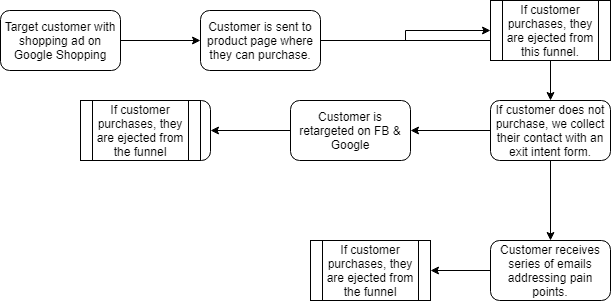Background
If you are a business owner, you likely hear buzzwords like “marketing funnel”, “lead generation”, “sales funnel” etc on a regular basis from marketing professionals trying to gain you as a client, or via advertisements on the web. Education is key in order to decipher between the garbage and the good stuff. So, I’m going to break down what a marketing funnel is, and how you can use this type of thinking to grow your business, be it on or offline.
A marketing funnel is essentially a roadmap of the journey a person takes before they become a customer or client. In a perfect world, your potential customer would land on your website, understand that you have the best product or are the best person for the job, and then complete a purchase.
Not So Simple
Unfortunately, it isn’t so simple. Perhaps a customer is the nervous type and doesn’t like to make a quick purchase decision. Or maybe, your lead isn’t confident you can deliver what you are promising. Whatever the case, the fact is that in eCommerce a 2% conversion is normal. This means that 98% of the people who visit your site won’t purchase whatever you are selling.
There are many reasons for this. Sometimes, it is the price. Perhaps you didn’t have the brand they wanted. Maybe, they couldn’t find what they are looking for? But often times, the reasons people fail to convert are emotional and trust based. By researching your niche and putting yourself in your customer’s shoes, you can envision all the potential issues that may arise that would prevent a prospect from becoming a customer, and then address them by taking them into account in your marketing funnel.
So What Is A Marketing Funnel Exactly?
The easiest way to explain it is by giving an example of one:
- You target a potential customer using Google PPC Shopping ads with an ad sending them to a product page. Hopefully, they purchase on the first visit, but what if they don’t?
- Someone who clicked on your ad is a valuable prospect. So you set up an exit intent pop-up offering something of value (some free information say) to get their contact information.
- If you got their contact information, now, you can send them an email series to try and address the potential pain points (price, trust, service).
- If you didn’t get their email address, you can still retarget them on Google’s content network and on Facebook.

So this is a very basic marketing funnel for an eCommerce business. To help you visualize it, I created the graphic below using draw.io. We can get much more complex with this by breaking different types of customers, and then targeting based on their details. For example, I created a series of emails that go out to leads that a client failed to close. Because there were four common reasons why clients failed to close, we created 4 different email series to go out to the leads depending on the reason they were lost. The same can be done for your retargeting ads etc.
Be aware
You can always hire an amazing marketer to do this for you (ahem) but if you wanted to do it yourself, you can. Setting up an exit intent email collection is fairly simple and can be done with MailChimp for example. Retargeting ads can be set up with easy to follow instructions from Google & Facebook, and sending an automated email series can also be set up in MailChimp.
Obviously, the more you learn about digital marketing, the better. And I would suggest that before spending money on paid ads, do a lot of homework – you don’t want to throw your money away, or hire a reputable marketing firm.

